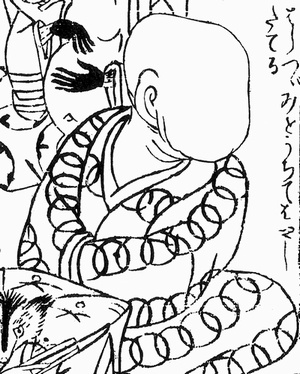Noppera-bō
Noppera-bō (のっぺら坊), also known as the faceless ghost, is a mythical creature or Yōkai from Japanese folklore. It resembles a human being in form but is characterized by its lack of facial features. The Noppera-bō is known for its ability to frighten humans by initially appearing as a mundane person before wiping away its features to reveal a smooth, blank face.
Legend[edit | edit source]
The legend of the Noppera-bō is prevalent throughout Japan, with numerous tales and accounts varying slightly between regions. A common narrative involves a late-night encounter with a seemingly ordinary individual. As the unsuspecting person engages with them, the Noppera-bō reveals its true nature, causing shock and fear. Despite its eerie appearance, the Noppera-bō is not typically known to cause physical harm. Instead, it delights in the terror it instills in humans.
Cultural Significance[edit | edit source]
The Noppera-bō has been a subject of Japanese art and literature for centuries, embodying themes of identity, the unknown, and the uncanny. It reflects the cultural fascination with the supernatural and the myriad forms that spirits and ghosts can take within Japanese folklore. The Noppera-bō also appears in modern media, including manga, anime, and horror films, showcasing its enduring appeal and versatility as a source of suspense and horror.
Comparative Mythology[edit | edit source]
The concept of faceless entities is not unique to Japan. Similar figures can be found in various cultures' folklore, where they serve as omens or manifestations of fear. However, the Noppera-bō is distinct in its benign nature, primarily seeking to scare rather than harm. This sets it apart from more malevolent spirits found in other traditions.
In Popular Culture[edit | edit source]
The Noppera-bō has influenced a wide range of media, from traditional kabuki plays to contemporary horror stories. Its ability to instill an immediate sense of dread with the simple act of removing its face has made it a compelling figure for exploring themes of identity, the unknown, and the nature of fear itself.
See Also[edit | edit source]
Search WikiMD
Ad.Tired of being Overweight? Try W8MD's physician weight loss program.
Semaglutide (Ozempic / Wegovy and Tirzepatide (Mounjaro / Zepbound) available.
Advertise on WikiMD
|
WikiMD's Wellness Encyclopedia |
| Let Food Be Thy Medicine Medicine Thy Food - Hippocrates |
Translate this page: - East Asian
中文,
日本,
한국어,
South Asian
हिन्दी,
தமிழ்,
తెలుగు,
Urdu,
ಕನ್ನಡ,
Southeast Asian
Indonesian,
Vietnamese,
Thai,
မြန်မာဘာသာ,
বাংলা
European
español,
Deutsch,
français,
Greek,
português do Brasil,
polski,
română,
русский,
Nederlands,
norsk,
svenska,
suomi,
Italian
Middle Eastern & African
عربى,
Turkish,
Persian,
Hebrew,
Afrikaans,
isiZulu,
Kiswahili,
Other
Bulgarian,
Hungarian,
Czech,
Swedish,
മലയാളം,
मराठी,
ਪੰਜਾਬੀ,
ગુજરાતી,
Portuguese,
Ukrainian
Medical Disclaimer: WikiMD is not a substitute for professional medical advice. The information on WikiMD is provided as an information resource only, may be incorrect, outdated or misleading, and is not to be used or relied on for any diagnostic or treatment purposes. Please consult your health care provider before making any healthcare decisions or for guidance about a specific medical condition. WikiMD expressly disclaims responsibility, and shall have no liability, for any damages, loss, injury, or liability whatsoever suffered as a result of your reliance on the information contained in this site. By visiting this site you agree to the foregoing terms and conditions, which may from time to time be changed or supplemented by WikiMD. If you do not agree to the foregoing terms and conditions, you should not enter or use this site. See full disclaimer.
Credits:Most images are courtesy of Wikimedia commons, and templates Wikipedia, licensed under CC BY SA or similar.
Contributors: Prab R. Tumpati, MD

